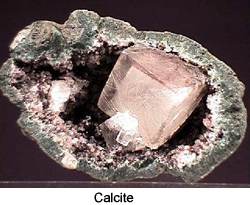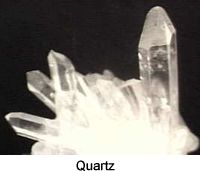BACKGROUND:
Minerals are composed of one or more elements. Since
there are many elements, many combinations are possible; geologists have
thus recognized thousands of different minerals. Minerals are important in a
number of ways. Minerals are the building blocks of rocks. They are
important to the world’s economy. Minerals such as gold and silver can
determine the wealth of a nation.
 Other
minerals are admired because of their beauty, such as rubies and emeralds.
Still other minerals are used in industry, such as chromite, a chromium ore,
which is used to harden metals. Finally, minerals are very useful in
everyday objects such as watches (quartz) and plaster (gypsum). Other
minerals are admired because of their beauty, such as rubies and emeralds.
Still other minerals are used in industry, such as chromite, a chromium ore,
which is used to harden metals. Finally, minerals are very useful in
everyday objects such as watches (quartz) and plaster (gypsum).
A mineral is "a naturally occurring, inorganic
element or compound with a definite chemical composition, a characteristic
crystalline structure, and distinct chemical properties." For example
graphite, which is made up of the element carbon, is soft, so it easily
writes on paper. The "lead" in pencils is really graphite. Mica is
composed of silicon, oxygen, iron, and aluminum. It forms very thin crystals
that flake off into sheets. Mica is used as glitter in some make up. Pyrite
is an iron sulfide that has a metallic luster (shiny like metal) and brassy
color. Many people mistake this for real gold, hence its common name
"fools’ gold." Magnetite is an iron oxide is naturally magnetic
and very dense.
 Key
characteristics, are unchanging properties of a substance. They can thus be
reliably used to identify that substance. Minerals have key characteristics.
These include: Key
characteristics, are unchanging properties of a substance. They can thus be
reliably used to identify that substance. Minerals have key characteristics.
These include:
- CRYSTAL FORM - The natural growth (shape) of a
mineral.
- FRACTURE AND CLEAVAGE -The way a mineral breaks.
Fracture is irregular breakage. For example, quartz has a conchoidal
fracture; it breaks along hollowed and rounded, uneven surfaces.
Cleavage is a regular breakage that follows the atomic structure of a
mineral. Cleavage results in smooth, planar surfaces. Different minerals
may have one, two, three, four, or six cleavages.
- HARDNESS - The mineral’s resistance to
scratching. It is controlled by the strength of atomic bonds within the
mineral. Mineral hardness is rated from 1 (soft) to 10 (hard) on the
Mohs hardness scale.
- SPECIFIC GRAVITY - The density of a mineral
relative to water.
- STREAK - The color of a powdered mineral sample.
- LUSTER - The way that a mineral reflects light.
There are two types of luster. Metallic minerals look like shiny or
rusted metal. Nonmetallic elements reflect light like glass or pearls or
glue.
- TASTE - Certain minerals like halite (salty) and
sulfur (bitter) have characteristic "flavors."
- MAGNETISM - The attraction of a mineral to a
magnet.
- REACTION TO ACID - The mineral reacts by
"fizzing" with dilute HCl reacts with carbonate minerals.
PROCEDURE:
-
Discuss the difference between the words
"characteristic" and "key characteristics" You
can illustrate key characteristics by asking the students how they can
recognize you. Use the following chart for guidance.
|
How People Recognize Me Now |
Characteristics That I Will
Still Have in Twenty Years
|
|
hair color |
skin color |
|
voice |
mouth shape |
|
height |
Ear and eye shape |
-
Illustrate key characteristics using
quartz, calcite, and halite. These minerals have very distinct key
characteristics that the students can easily observe.
-
Quartz: Crystals always make
a pointed pencil shape. It has 6 sides on terminal ends, resembling a
prism. It is very hard (7 on the Mohs hardness scale). A steel knife
will not scratch quartz. Quartz crystals are usually clear, but can
occur in almost any color.
-
Calcite: Shows a
rhombohendral crystal shape. This can be described as a
"drunken" or tilted 3-dimensional rectangle. Calcite fizzes
readily with HCl. It is soft (about 3 on the hardness scale) and is
easily scratched with a knife. Calcite may be clear to yellow in
color. When a clear calcite crystal is placed over an image or word,
it appears doubled when viewed through the crystal. This is called
double refraction.
-
Halite: Tastes like salt,
because it is salt. Halite has a cubic crystal form, so it cleaves
into perfect cubes. It has roughly the same hardness as calcite, and
is colorless. Although taste is an important characteristic, caution
students to avoid tasting minerals; some minerals have very unpleasant
tastes.
-
Since these three minerals above can be
clear in color, ask the students if color is a good key characteristic.
Next, ask them how they would tell these minerals apart. Each of the
minerals has its own key characteristics of hardness, shape, or taste.
Color in this case is not a key characteristic.
|